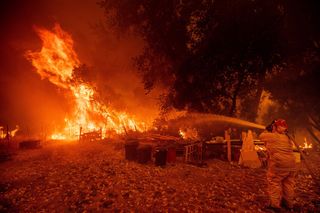California Logged Its Hottest Month Ever, and Things Are Only Going to Get Worse

As wildfires burn huge swaths of California, the month of July blazed through climate records.
It was not only the hottest July in California's history, but it was also the state's hottest month ever, according to a new report issued Wednesday (Aug. 15) by the National Oceanic and Atmospheric Administration (NOAA).
Across the U.S., July was also hotter than usual. Average temperatures in the lower 48 states climbed to 75.5 degrees Fahrenheit (24.2 degrees Celsius). At 1.9 degrees F higher than the 20th century average, these sizzling temperatures rendered the month the 11th hottest July on record for the U.S., NOAA scientists reported at a press briefing. [Wildfires Blaze in Northern California (Photos)]
In fact, the three-month stretch from May to July was the hottest such period in the U.S. to date, according to the report. During that time, average temperatures reached 70.9 degrees F (21.6 degrees C), beating the previous record of 70.6 degrees F (21.4 degrees C), set in 1934.
Things were even more scorching in Death Valley. The blazing-hot desert experienced the hottest month observed anywhere on Earth, with average temperatures of 108.1 degrees F (42.3 degrees C). Arid, hot conditions baked Western states and lay the groundwork for destructive fires, particularly in Colorado and California. Many of the blazes have continued to burn into the month of August, and they have so far torched hundreds of thousands of acres.
More than one-third of the U.S. was undergoing drought in July — 34.1 percent, up from 29.7 percent at the beginning of the month. In Hawaii alone, drought conditions expanded to affect 30 percent of the state. However, Pennsylvania saw record amounts of moisture. With rainfall at 176 percent of average precipitation levels, this was Pennsylvania's wettest July on record.
Warm, dry conditions are expected to persist through November, and heaps of dry brush in Western states could keep large wildfires burning into the fall, Tim Brown, a director with NOAA's Western Regional Climate Center, announced at the news briefing. Wildfires may also be exacerbated by a climate trend that has emerged in recent decades; nighttime temperatures are remaining high, reducing humidity and making dead vegetation more likely to burn, leading to longer fires and more smoke production, Brown explained. And there isn't much relief in sight. Seasonal temperatures are likely to remain above normal in most of the U.S. through November, though above-average precipitation is anticipated in the southwest, according to the report.
Sign up for the Live Science daily newsletter now
Get the world’s most fascinating discoveries delivered straight to your inbox.
Original article on Live Science.

Mindy Weisberger is an editor at Scholastic and a former Live Science channel editor and senior writer. She has reported on general science, covering climate change, paleontology, biology, and space. Mindy studied film at Columbia University; prior to Live Science she produced, wrote and directed media for the American Museum of Natural History in New York City. Her videos about dinosaurs, astrophysics, biodiversity and evolution appear in museums and science centers worldwide, earning awards such as the CINE Golden Eagle and the Communicator Award of Excellence. Her writing has also appeared in Scientific American, The Washington Post and How It Works Magazine.
Most Popular

